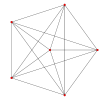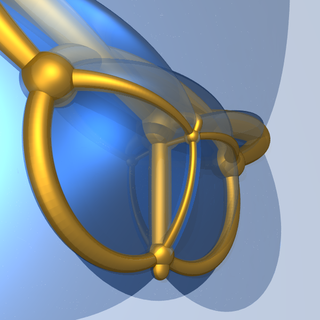5-simplex
| 5-simplex Hexateron (hix) | ||
|---|---|---|
| Type | uniform 5-polytope | |
| Schläfli symbol | {34} | |
| Coxeter diagram | ||
| 4-faces | 6 | 6{3,3,3} |
| Cells | 15 | 15{3,3} |
| Faces | 20 | 20{3} |
| Edges | 15 | |
| Vertices | 6 | |
| Vertex figure |  5-cell | |
| Coxeter group | A5,[34], order 720 | |
| Dual | self-dual | |
| Base point | (0,0,0,0,0,1) | |
| Circumradius | 0.645497 | |
| Properties | convex,isogonalregular,self-dual | |
Infive-dimensionalgeometry,a 5-simplexis a self-dualregular5-polytope.It has sixvertices,15edges,20 trianglefaces,15 tetrahedralcells,and 65-cellfacets.It has adihedral angleof cos−1(1/5), or approximately 78.46°.
The 5-simplex is a solution to the problem:Make 20 equilateral triangles using 15 matchsticks, where each side of every triangle is exactly one matchstick.
Alternate names
[edit]It can also be called ahexateron,orhexa-5-tope,as a 6-facettedpolytope in 5-dimensions. Thenamehexateronis derived fromhexa-for having sixfacetsandteron(withter-being a corruption oftetra-) for having four-dimensional facets.
By Jonathan Bowers, a hexateron is given the acronymhix.[1]
As a configuration
[edit]Thisconfiguration matrixrepresents the 5-simplex. The rows and columns correspond to vertices, edges, faces, cells and 4-faces. The diagonal numbers say how many of each element occur in the whole 5-simplex. The nondiagonal numbers say how many of the column's element occur in or at the row's element. This self-dual simplex's matrix is identical to its 180 degree rotation.[2][3]
Regular hexateron cartesian coordinates
[edit]Thehexateroncan be constructed from a5-cellby adding a 6th vertex such that it is equidistant from all the other vertices of the 5-cell.
TheCartesian coordinatesfor the vertices of an origin-centered regular hexateron having edge length 2 are:
The vertices of the5-simplexcan be more simply positioned on ahyperplanein 6-space as permutations of (0,0,0,0,0,1)or(0,1,1,1,1,1). These constructions can be seen as facets of the6-orthoplexorrectified 6-cuberespectively.
Projected images
[edit]| Ak Coxeter plane |
A5 | A4 |
|---|---|---|
| Graph | 
|

|
| Dihedral symmetry | [6] | [5] |
| Ak Coxeter plane |
A3 | A2 |
| Graph | 
|

|
| Dihedral symmetry | [4] | [3] |
 Stereographic projection4D to 3D ofSchlegel diagram5D to 4D of hexateron. |
Lower symmetry forms
[edit]A lower symmetry form is a5-cell pyramid{3,3,3}∨( ), with [3,3,3] symmetry order 120, constructed as a5-cellbase in a 4-spacehyperplane,and anapexpointabovethe hyperplane. The fivesidesof the pyramid are made of 5-cell cells. These are seen asvertex figuresof truncated regular6-polytopes,like atruncated 6-cube.
Another form is {3,3}∨{ }, with [3,3,2,1] symmetry order 48, the joining of an orthogonal digon and a tetrahedron, orthogonally offset, with all pairs of vertices connected between. Another form is {3}∨{3}, with [3,2,3,1] symmetry order 36, and extended symmetry [[3,2,3],1], order 72. It represents joining of 2 orthogonal triangles, orthogonally offset, with all pairs of vertices connected between.
The form { }∨{ }∨{ } has symmetry [2,2,1,1], order 8, extended by permuting 3 segments as [3[2,2],1] or [4,3,1,1], order 48.
These are seen in thevertex figuresofbitruncatedand tritruncated regular 6-polytopes, like abitruncated 6-cubeand atritruncated 6-simplex.The edge labels here represent the types of face along that direction, and thus represent different edge lengths.
The vertex figure of theomnitruncated 5-simplex honeycomb,![]()
![]()
![]()
![]()
![]()
![]()
![]() ,is a 5-simplex with apetrie polygoncycle of 5 long edges. Its symmetry is isomophic to dihedral group Dih6or simple rotation group [6,2]+,order 12.
,is a 5-simplex with apetrie polygoncycle of 5 long edges. Its symmetry is isomophic to dihedral group Dih6or simple rotation group [6,2]+,order 12.
| Join | {3,3,3}∨( ) | {3,3}∨{ } | {3}∨{3} | { }∨{ }∨{ } | |
|---|---|---|---|---|---|
| Symmetry | [3,3,3,1] Order 120 |
[3,3,2,1] Order 48 |
[[3,2,3],1] Order 72 |
[3[2,2],1,1]=[4,3,1,1] Order 48 |
~[6] or ~[6,2]+ Order 12 |
| Diagram | 
|

|

|

|

|
| Polytope | truncated 6-simplex |
bitruncated 6-simplex |
tritruncated 6-simplex |
3-3-3 prism |
Omnitruncated 5-simplex honeycomb |
Compound
[edit]The compound of two 5-simplexes in dual configurations can be seen in this A6Coxeter planeprojection, with a red and blue 5-simplex vertices and edges. This compound has [[3,3,3,3]] symmetry, order 1440. The intersection of these two 5-simplexes is a uniformbirectified 5-simplex.![]()
![]()
![]()
![]()
![]() =
=![]()
![]()
![]()
![]()
![]() ∩
∩![]()
![]()
![]()
![]()
![]() .
.
Related uniform 5-polytopes
[edit]It is first in a dimensional series of uniform polytopes and honeycombs, expressed byCoxeteras 13kseries. A degenerate 4-dimensional case exists as 3-sphere tiling, a tetrahedralhosohedron.
| Space | Finite | Euclidean | Hyperbolic | |||
|---|---|---|---|---|---|---|
| n | 4 | 5 | 6 | 7 | 8 | 9 |
| Coxeter group |
A3A1 | A5 | D6 | E7 | =E7+ | =E7++ |
| Coxeter diagram |
||||||
| Symmetry | [3−1,3,1] | [30,3,1] | [31,3,1] | [32,3,1] | [[33,3,1]] | [34,3,1] |
| Order | 48 | 720 | 23,040 | 2,903,040 | ∞ | |
| Graph | 
|

|

|
- | - | |
| Name | 13,-1 | 130 | 131 | 132 | 133 | 134 |
It is first in a dimensional series of uniform polytopes and honeycombs, expressed byCoxeteras 3k1series. A degenerate 4-dimensional case exists as 3-sphere tiling, a tetrahedraldihedron.
| Space | Finite | Euclidean | Hyperbolic | |||
|---|---|---|---|---|---|---|
| n | 4 | 5 | 6 | 7 | 8 | 9 |
| Coxeter group |
A3A1 | A5 | D6 | E7 | =E7+ | =E7++ |
| Coxeter diagram |
||||||
| Symmetry | [3−1,3,1] | [30,3,1] | [[31,3,1]] = [4,3,3,3,3] |
[32,3,1] | [33,3,1] | [34,3,1] |
| Order | 48 | 720 | 46,080 | 2,903,040 | ∞ | |
| Graph | 
|

|

|
- | - | |
| Name | 31,-1 | 310 | 311 | 321 | 331 | 341 |
The 5-simplex, as 220polytope is first in dimensional series 22k.
| Space | Finite | Euclidean | Hyperbolic | ||
|---|---|---|---|---|---|
| n | 4 | 5 | 6 | 7 | 8 |
| Coxeter group |
A2A2 | A5 | E6 | =E6+ | E6++ |
| Coxeter diagram |
|||||
| Graph | 
|

|
∞ | ∞ | |
| Name | 22,-1 | 220 | 221 | 222 | 223 |
The regular 5-simplex is one of 19uniform polyterabased on the [3,3,3,3]Coxeter group,all shown here in A5Coxeter planeorthographic projections.(Vertices are colored by projection overlap order, red, orange, yellow, green, cyan, blue, purple having progressively more vertices)
| A5 polytopes | |||||||||||
|---|---|---|---|---|---|---|---|---|---|---|---|
 t0 |
 t1 |
 t2 |
 t0,1 |
 t0,2 |
 t1,2 |
 t0,3 | |||||
 t1,3 |
 t0,4 |
 t0,1,2 |
 t0,1,3 |
 t0,2,3 |
 t1,2,3 |
 t0,1,4 | |||||
 t0,2,4 |
 t0,1,2,3 |
 t0,1,2,4 |
 t0,1,3,4 |
 t0,1,2,3,4 | |||||||
See also
[edit]Notes
[edit]- ^Klitzing, Richard."5D uniform polytopes (polytera) x3o3o3o3o — hix".
- ^Coxeter 1973,§1.8 Configurations
- ^Coxeter, H.S.M. (1991).Regular Complex Polytopes(2nd ed.). Cambridge University Press. p. 117.ISBN9780521394901.
References
[edit]- Gosset, T.(1900). "On the Regular and Semi-Regular Figures in Space of n Dimensions".Messenger of Mathematics.Macmillan. pp. 43–.
- Coxeter, H.S.M.:
- — (1973). "Table I (iii): Regular Polytopes, three regular polytopes in n-dimensions (n≥5)".Regular Polytopes(3rd ed.). Dover. pp.296.ISBN0-486-61480-8.
- Sherk, F. Arthur; McMullen, Peter; Thompson, Anthony C.; Weiss, Asia Ivic, eds. (1995).Kaleidoscopes: Selected Writings of H.S.M. Coxeter.Wiley.ISBN978-0-471-01003-6.
- (Paper 22)— (1940)."Regular and Semi Regular Polytopes I".Math. Zeit.46:380–407.doi:10.1007/BF01181449.S2CID186237114.
- (Paper 23)— (1985)."Regular and Semi-Regular Polytopes II".Math. Zeit.188(4): 559–591.doi:10.1007/BF01161657.S2CID120429557.
- (Paper 24)— (1988)."Regular and Semi-Regular Polytopes III".Math. Zeit.200:3–45.doi:10.1007/BF01161745.S2CID186237142.
- Conway, John H.;Burgiel, Heidi; Goodman-Strauss, Chaim (2008). "26. Hemicubes: 1n1".The Symmetries of Things.p. 409.ISBN978-1-56881-220-5.
- Johnson, Norman(1991). "Uniform Polytopes" (Manuscript). Norman Johnson.
- Johnson, N.W. (1966).The Theory of Uniform Polytopes and Honeycombs(PhD). University of Toronto.
External links
[edit]- Olshevsky, George."Simplex".Glossary for Hyperspace.Archived fromthe originalon 4 February 2007.
- Polytopes of Various Dimensions,Jonathan Bowers
- Multi-dimensional Glossary


![{\displaystyle {\begin{aligned}&\left({\tfrac {1}{\sqrt {15}}},\ {\tfrac {1}{\sqrt {10}}},\ {\tfrac {1}{\sqrt {6}}},\ {\tfrac {1}{\sqrt {3}}},\ \pm 1\right)\\[5pt]&\left({\tfrac {1}{\sqrt {15}}},\ {\tfrac {1}{\sqrt {10}}},\ {\tfrac {1}{\sqrt {6}}},\ -{\tfrac {2}{\sqrt {3}}},\ 0\right)\\[5pt]&\left({\tfrac {1}{\sqrt {15}}},\ {\tfrac {1}{\sqrt {10}}},\ -{\tfrac {\sqrt {3}}{\sqrt {2}}},\ 0,\ 0\right)\\[5pt]&\left({\tfrac {1}{\sqrt {15}}},\ -{\tfrac {2{\sqrt {2}}}{\sqrt {5}}},\ 0,\ 0,\ 0\right)\\[5pt]&\left(-{\tfrac {\sqrt {5}}{\sqrt {3}}},\ 0,\ 0,\ 0,\ 0\right)\end{aligned}}}](https://wikimedia.org/api/rest_v1/media/math/render/svg/b79141ce810582c49e87824bc8b0f8a7ccec5d90)



